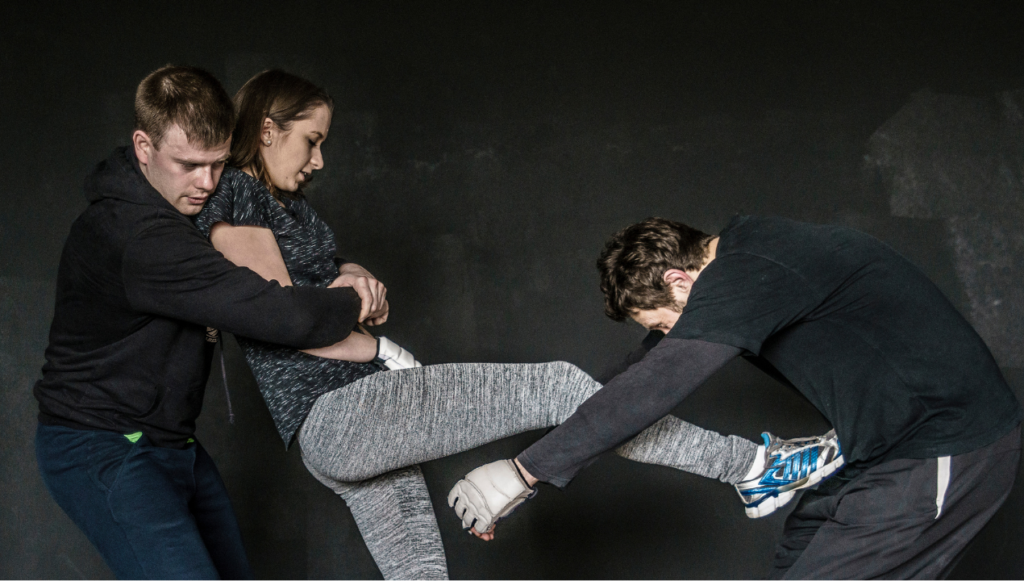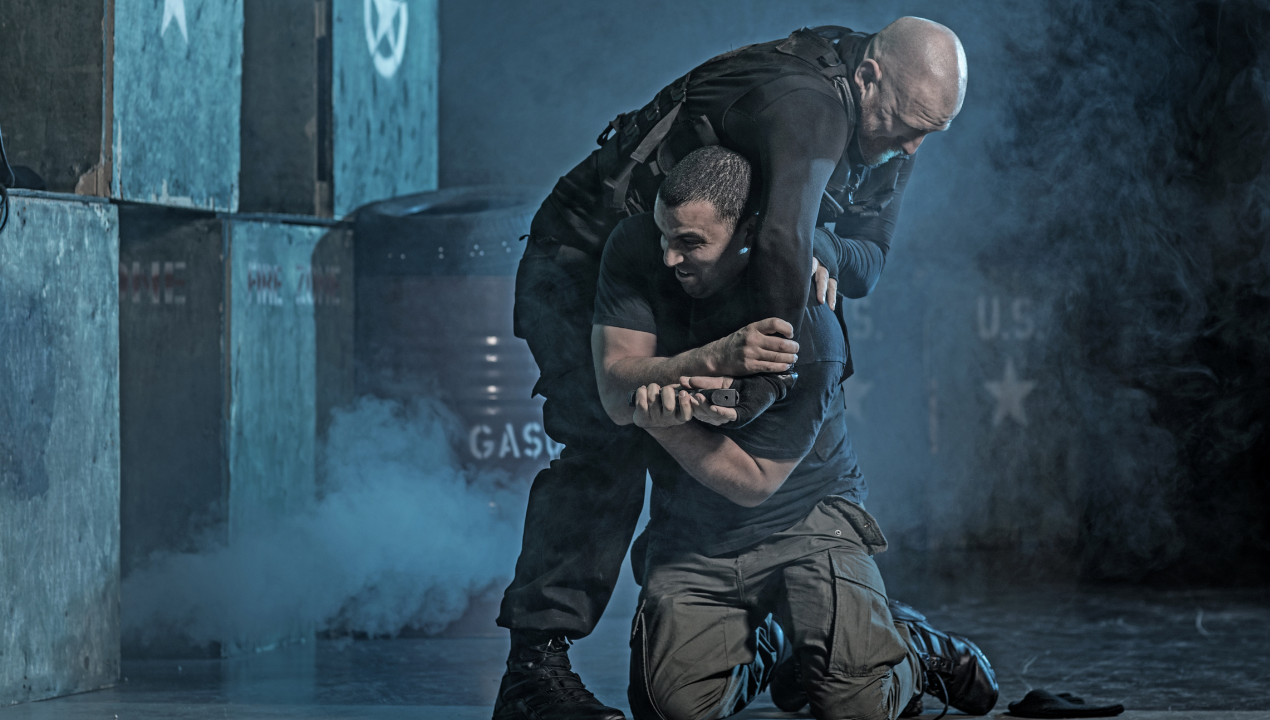This article will put Krav Maga vs Brazilian Jiu Jitsu to see which will be most effective for you to learn and defend yourself.
These are two well-known fighting styles in
We’ll see how they measure against each other and help you decide which one is the right fit for you.
Let’s get started!
What is Brazilian Jiu-Jitsu?
Brazilian Jiu-Jitsu is an evolution of Japanese Jiu Jitsu.
Traditional Jiu-Jitsu comes from Judo (see Judo vs Brazilian Jiu Jitsu) and was introduced to Brazil by a Japanese master named Maeda, who was part of a diplomatic mission to help establish Japanese settlements in the country in the early 1900s.
In the subsequent years, the Gracie family, led by Royce Gracie, adapted and conceived new techniques to make it truly unique and improved from its Japanese predecessor.
The Gracies have become synonymous with the sport. They have used their craft to amaze both fighters and audiences of
BJJ does not emphasize striking. Instead, it teaches fighters a variety of submission techniques for ground fighting.
These ground techniques include joint locks and holds that can neutralize the strength of a bigger and stronger opponent.
An important aspect of Brazilian Jiu-Jistu is also been said to help develop patience, calm, and humility.
Today BJJ is one of the pillars of Mixed Martial Arts.
Brazilian Jiujitsu Belt System
We have written extensively on the subject of the BJJ belt system.
Essentially, the BJJ belt ranking systems recognize five belt color levels given in the following order: white, blue, purple, brown, and black.
Most traditional schools adhere to rules set by the International Brazilian Jiu-Jitsu Federation (IBJJF).
A person can only progress when their coach feels they are ready. Coaches and professors generally take into account a few different factors when deciding to promote Brazilian Jiu-Jitsu students, including:
- Time practicing on the mat
- Length of time at the current level
- Skill level
- Dedication to the sport, school, and teammates
There are no shortcuts in BJJ. Each belt typically requires two years of training, and achieving a black belt will usually require 10 years of full-time training to achieve.
What Is Krav Maga?
Krav Maga is a combat system created by a Hungarian Jewish martial artist Imi Lichtenfeld in the years before World War II. He used his street-fight experiences and was motivated to create a system to help defend Jewish communities.
Krav Maga incorporates elements of boxing, wrestling, Judo, Karate, and Aikido and is designed to overwhelm an opponent with aggression.
Krav Maga is not a sporting martial art. It is primarily one of the military self-defense and fighting systems. Today it is used by the Israeli military and is also incorporated into the training of several law enforcement agencies in North America.
Because it is not a sport, there are no rules for practitioners. Krav Maga emphasizes a series of techniques, such as throat strikes, eye gouges, and groin strikes.
Krav Maga does not shy away from teaching deadly techniques; training also includes staying calm in stressful situations. Fighters should remain unemotional when resorting to violence. At the same time, remaining calm is important to defuse dangerous situations.
If violence is inevitable, Krav Maga’s main objective is to keep the practitioner alive by any means necessary.
Some people might say that Krav Maga emphasizes “dirty moves,” but the self-defense system is designed to be effective rather than beautiful.
Weapons Training is also a component of Krav Maga.
Fighters will learn how to disarm an opponent and use various items as weapons. This makes it particularly useful for law enforcement personnel.
Krav Maga Belt System
Krav Maga follows a belt system based on the belt system from Judo. It starts with a white belt, and then a yellow belt, orange belt, green belt, blue belt, brown belt, and finally, a black belt.
It typically takes four months for a Krav Maga practitioner to progress from white belt to yellow belt. To progress to the Orange belt typically takes six months. Green and Blue belts typically require nine months of training for each. And to achieve Brown and Black belts require a minimum of twelve months each of intense training.
Black belt students can progress through levels beginning at 1st degree all the way to 7th degree, 8th degree, and 10th degrees.
As you can imagine, the training becomes progressively more difficult and demanding as a fighter advances through the belts.
What is the difference between Krav Maga and Jiu-Jitsu?
Comparing two martial arts will always generate strong opinions from those who practice either.
Comparing Krav Maga and Brazilian Jiujitsu is like comparing apples to oranges in some ways.
One of the key differences is the fact that Krav Maga is identified as a combat system. It is not a sport that emphasizes friendly competition and sportsmanship. The objective is to train practitioners to survive in no-holds-barred combat situations.

On the other hand, BJJ is a martial art that emphasizes competition and sportsmanship. There are rules in competition to ensure that practitioners do not end up seriously getting injured.
But BJJ isn’t just a sport. As a martial art, it also stands out for its practical application in real combat. It is often said that most real fights end up on the ground, and that is where BJJ thrives.
Krav Maga makes every effort to make sure fights don’t end up on the ground. Krav Maga practitioners are taught effective techniques.
Krav Maga vs BJJ: Which is most effective?
Both Krav Maga and BJJ stand out for being styles that apply to real-world situations.
A skilled BJJ grappler can overcome a much bigger and stronger opponent without causing serious injury in a street fight.
A Krav Maga fighter can also overcome a bigger, strong opponent in a street fight, although injury is very likely.
But Krav Maga is a combat style that is suitable for desperate street fighting situations where people find themselves in a fight for survival.
The techniques used in Krav Maga are more vicious than BJJ and could result in criminal charges being pressed as there is a serious risk of injuring an opponent. In fact, that is the intention.
BJJ is helpful for subduing a single opponent, but it is not suitable in real street fighting when a person faces multiple opponents. A BJJ practitioner may be able to use grappling on the ground to neutralize the threat of one opponent, but they will be vulnerable to strikes from other attackers simultaneously.
Krav Maga, like Combat Sambo, is a combat system that anticipates the likelihood of multiple opponents. For that reason, Krav Maga teaches to strike first and strike hard so that a fighter can quickly neutralize one opponent to be able to move on to the next.
Compassion is not a part of Krav Maga, and people who practice it are reminded not to stop attacking an opponent until they pose absolutely no further threat.
A kick to the balls isn’t a beautiful technique, but it will likely get the job done. For this reason, we believe that Krav Maga is a more effective style for survival.
Krav Maga vs Brazilian Jiu Jitsu in Closing
There you have it.
Krav Maga may win due to its sheer brutality, but BJJ is certainly a great martial art for someone to learn to protect themself.
Both are great for defending against larger enemies, so this is great for anyone to learn.
